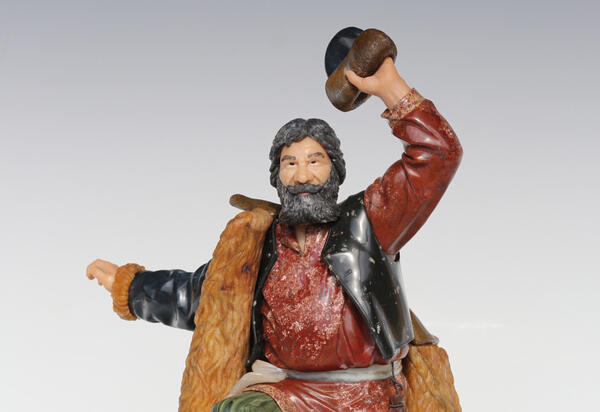The composition “Merchant” was made in the Yekaterinburg workshop “Stone-Cutting House of Alexey Antonov”. Several people worked on the volumetric mosaic. Timofey Paus created the sketches for it, Oleg Opalev carved the figurine, and Pavel Vetrov made the metal parts.
This figurine of the craftsmen was inspired by a story from the life of industrialist Prokofi Demidov. At the age of 36, he inherited a huge fortune and often arranged unusual recreational activities: solemn processions with giants and ponies, practical jokes with live garden statues that depicted chalk-covered servants. Once Demidov wanted to ride a sleigh in the middle of the summer. So, he ordered to fill an entire street with salt, which imitated snow. At that time, salt was very expensive, thus, this whim cost him a huge amount.
Craftsmen portrayed the merchant in motion: he raises his leg, as if he is going to tap with joy or start dancing. In his raised hand, he holds a fur-trimmed hat.
Volumetric mosaics became fashionable at the turn of the 19th century thanks to the works of Carl Fabergé and Alexey Denisov-Uralsky. Fabergé workshops produced figurines of literary characters and compositions from the “Russian Types” series using this technique. Moreover, Denisov-Uralsky created allegorical images of the states that participated in the First World War. In Soviet times, master Vasily Konovalenko worked in the volumetric mosaic technique: he carved an entire gallery of literary heroes and characters in Ukrainian national costumes. Konovalenko made not only individual figurines, but also multi-figure compositions.
In 2000, a Yekaterinburg stone-carver, Alexey Antonov founded his own artistic workshop and invited a team of specialists to work with precious and ornamental stones. Artists create figurines of fairy-tale characters and heroes of popular films, as well as genre scenes in a traditional folk style.
Alexey Antonov donated the composition “Merchant” to the Museum of Stone-Cutting and Jewelry Art History in 2018, at the opening of the inter-museum exhibition project “Followers of Fabergé. Stone in Russian Art “.
This figurine of the craftsmen was inspired by a story from the life of industrialist Prokofi Demidov. At the age of 36, he inherited a huge fortune and often arranged unusual recreational activities: solemn processions with giants and ponies, practical jokes with live garden statues that depicted chalk-covered servants. Once Demidov wanted to ride a sleigh in the middle of the summer. So, he ordered to fill an entire street with salt, which imitated snow. At that time, salt was very expensive, thus, this whim cost him a huge amount.
Craftsmen portrayed the merchant in motion: he raises his leg, as if he is going to tap with joy or start dancing. In his raised hand, he holds a fur-trimmed hat.
Volumetric mosaics became fashionable at the turn of the 19th century thanks to the works of Carl Fabergé and Alexey Denisov-Uralsky. Fabergé workshops produced figurines of literary characters and compositions from the “Russian Types” series using this technique. Moreover, Denisov-Uralsky created allegorical images of the states that participated in the First World War. In Soviet times, master Vasily Konovalenko worked in the volumetric mosaic technique: he carved an entire gallery of literary heroes and characters in Ukrainian national costumes. Konovalenko made not only individual figurines, but also multi-figure compositions.
In 2000, a Yekaterinburg stone-carver, Alexey Antonov founded his own artistic workshop and invited a team of specialists to work with precious and ornamental stones. Artists create figurines of fairy-tale characters and heroes of popular films, as well as genre scenes in a traditional folk style.
Alexey Antonov donated the composition “Merchant” to the Museum of Stone-Cutting and Jewelry Art History in 2018, at the opening of the inter-museum exhibition project “Followers of Fabergé. Stone in Russian Art “.



